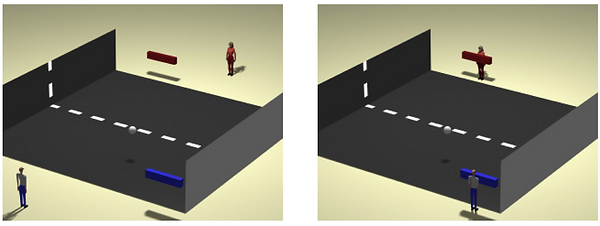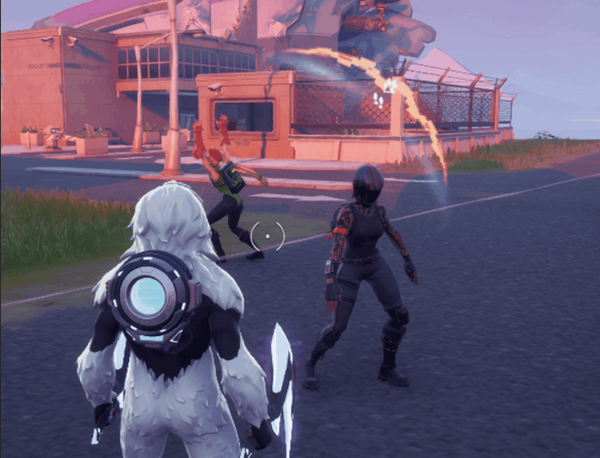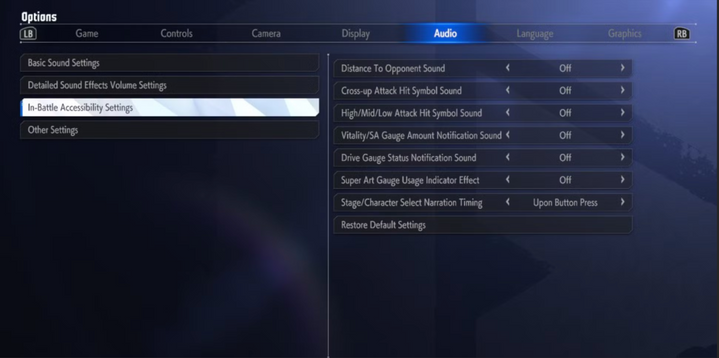Audio Accessibility
There are many types of accessibility needs, with the main categories falling under “Motor, Cognitive, Vision, Hearing and Speech” considerations ranging from requiring basic global game mechanic changes to advanced niche mechanics (Game Accessibility Guidelines, n.d.). An example of motor may be hardware and controller input mapping, for cognitive – accessible tutorialisation during gameplay and mission reminders, for vision – colour and brightness contrast considerations and audio cues, hearing – visual and likely haptic cues, and speech – potentially alternate speech input options and external hardware compatibility, or in game short hand speech buttons.
Some of the primary audiences for audio accessibility features may be “Players without vision; Players with low vision; and Players with cognitive or learning disabilities” or also gamers “playing in a noisy room” (Microsoft, n.d.). These features need to work across, music, narration, voice-over, sound effects (Microsoft, n.d.) and with online multiplayers especially voice chat.
With regards to audio accessibility specifically, some of the core methodologies include: systems (such as an audio ping feedback), telegraphing actions (such as a wind up sound to a punch impact in a fighting game), and environments (that give the spatialisation information of the surroundings).
In terms of large scale AAA games, full audio accessibility is relatively new, as Brandon Cole noted after working on The Last of Us Part 2 “ it is the FIRST AAA game EVER to feature full blind accessibility” (Bayliss, B. (2020) who worked on The Last of Us Part 1 and Part 2 (Cole & Levine, 2023). Each year the Game Accessibility Conference (have their awards for notable games that have pushed the quality of game accessibility in the industry in that year (GAConf, 2024). These games are recognised for the innovation and depth of features that are “celebrating the efforts…to raise the bar for accessibility” in the industry (GAConf, 2024). A few examples from the last few years for blind accessibility which have audio features as part of their innovation :
2024
- Star Wars Outlaws - Audio description for cinematics
- Diablo IV: Vessel of Hatred - Blind nav assist update, adding multi-layered audio cues to navigate to quest map markers (overworld navigation audio cues, first for ARPG genre)
2023
- Mortal Kombat 1 - Audio description for gameplay events
- Forza Motorsport - Accessible to totally blind players, including audio description for gameplay events
2022
- God of War Ragnarök
- The Last Of Us Part 1
Figure 1: Game Accessibility Conference Awards including audio features from 2022 to 2024 (GAConf, 2022, 2023, 2024)
References
Bayliss, B. (2020). The Last of Us 2 accessibility consultants: advancing the industry. Available at: https://caniplaythat.com/2020/06/23/the-last-of-us-2-accessibility-consultants-advancing-the-industry/ (Accessed: 29 November 2024).
Cole, B., & Levine, G. (2023). Making The Last of Us accessible for blind players. 80.lv. Available at: https://80.lv/articles/making-the-last-of-us-accessible-for-blind-players/ (Accessed: 29 November 2024).
Game Accessibility Conference (GAConf) (2022). GAConf Awards 2024. Available at: https://www.gaconf.com/gaconf-awards-2022/ (Accessed: 9 December 2024).
Game Accessibility Conference (GAConf) (2023). GAConf Awards 2024. Available at: https://www.gaconf.com/gaconf-awards-2023/ (Accessed: 9 December 2024).
Game Accessibility Conference (GAConf) (2024). GAConf Awards 2024. Available at: https://www.gaconf.com/gaconf-awards-2024/ (Accessed: 9 December 2024).
Game Accessibility Guidelines. (n.d.). Full list of guidelines. Available at: https://gameaccessibilityguidelines.com/full-list/ (Accessed: 1 December 2024).
Microsoft (n.d.). Accessibility Guidelines. Available at: https://learn.microsoft.com/en-us/gaming/accessibility/guidelines (Accessed: 9 December 2024).
Procedural Music Types
While a lot of video games can include extra options which aid with sound design, one subset of game accessibility focuses on Audio-Only games, designed specifically with no visual requirements to enjoy the games (Gnecco et al, 2024).
This strain of sound accessibility has accidental origins in the 1970’s arcade games. Because games were not designed with the visually impaired in mind, gamers had to rely on releases that essentially just happened to emphasise sound design that matched their needs (PaperWill, 2021). This included the early title Touch Me (1974), which had no screen but instead relied on four buttons with a distinct noise. Players would need to memorise the pattern the buttons made via the noise and the button lighting up, but it was accessible to play just purely by the sounds the buttons made (Prarazu et al, 2020).
Figure1: The arcade cabinet itself and gameplay (VintageVideoGamesCom, 2013).
A majorly innovative title was Real Sound: Kaze no Regret (1997). It was inspired after Kenji Eno, having receiving various letters from blind fans in appreciation of his earlier titles, visited a number of his visually impaired fans (PixellationMagazine, 2012). After discovering people playing action games and utilising the sound design to play to the best of their abilities, Eno commented (2008) on the fact that despite the kids being unable to enjoy the game traditionally, he imagined turning the screen off and playing the game with someone who was blind, enjoying the game on an equal playing field. Inspired by this, Eno created Kaze no Regret based entirely of sound, playing as a sound novel.
Figure 2: Gameplay (TroniC, 2009).
In 2007, AuditoryPong was developed as a version of Pong without the need of sight, and was developed with meticulous detail toward need and understanding of how the game could be played via auditory means, such as using a continuous, small melody alongside the ball and short sound effects for impacts against walls (Heuten et al, 2007).
Players can also use a visual display. Thus alongside this, People who are not visually impaired can actually play the game alongside those with visual disabilities - with the aid of adjustable handicaps - as an equal experience of gameplay (Heuten et al, 2007).

Figure 3: elements of several examples of the game layout - the people represent the virtual listener for two different styles of play - one in the centre in front of the field and the other behind the paddle at all times. (Heuten et al, 2007).
Around 2010, more audio-only games were designed using phones, utilising the gyro feature and touchscreen to create innovative methods for gamers to interact with a game using no visual elements. (PaperWill, 2021).
Blindside (2012) uses the gyros inside an iPhone or iPad to track which way the player is facing. Combining this with the 3D Sound of the game, one can play and be aware of their surroundings purely via sound cues, dialogue and sound effects. (Epicycle games, 2012).
Figure 4: Example of Blindside Gameplay (Epicyclegames, 2012).
References:
Agrimi, E. Battaglini, C., Bottari, D. Gnecco, G., Leporini, B. (2024) ‘Game Accessability for Visually Impaired People: A Review’ Soft Computing, 28, pp. 10475-10489.
Blindside (2012) Epicycle. Boston.
Epicyclegames (2012) BlindSide, an Introduction - Blind Accessible Audio-Only Survival Horror Game. Available at: <https://youtu.be/3jxskQgWoaE> [Accessed: 10 December 2024].
Heuten W, Henze N, Boll S, Klante P (2007) ‘AuditoryPong–playing pong in the dark’, Audio Mostly 2007 – 2nd Conference on Interaction with Sound, 2007. Available at: <https://nhenze.net/uploads/AuditoryPong-Playing-PONG-in-the-Dark.pdf> [Accessed: 10 December 2024].
PaperWill (2021) A (Blind Accessible) History of Blind Gaming. Available at: <https://youtu.be/oKgN4va-gas> [Accessed: 10 December 2024].
Pixellationmagazine (2012) What’s In The Box? Real Sound: Kaze No Regret. Available at: <https://pixellationmagazine.blogspot.com/2012/08/whats-in-box-real-sound-kaze-no-regret.html> [Accessed 10 December 2024].
Prarazu, A., Balan, O., Moldoveanu, A., Moldoveanu, F., Morar, A., Ivascu. S. (2020) ‘Overview on visually impaired gamers and game accessibility’, EDULEARN20 Proceedings: 12th International Conference on Education and New Learning Technologies [Conference], pp. 5491-5501. Available at: <https://www.researchgate.net/publication/343419037_OVERVIEW_ON_VISUALLY_IMPAIRED_GAMERS_AND_GAME_ACCESSIBILITY> [Accessed: 10 December 2024].
Real Sound: Kaze no Regret (1997) Warp. Tokyo.
Touch Me (1974) Atari Inc. Sunnyvale.
TroniC (2009) Real Sound: Kaze no Regret - First 10 min. gameplay-. Available at: <https://youtu.be/_jrGP098U6I> [Accessed: 10 December 2024].
VintageVideoGamesCom (2013) This is my rare 1974 Atari Touch Me game in all its glory. Available at: <https://youtu.be/VGY-wXvjWa0 > [Accessed: 10 December 2024].
Audio Accessibility in Competitive Games
Audio accessibility features allow for the extensive personalisation of a gameplay experience (Yuan et al., 2010). Within the context of competitive games, several developments in the accessibility space have become revolutionary gameplay innovations, with some being seen as must-have features for optimal competitive performance.
In Fortnite (Epic Games, 2017), a UI setting labelled ‘Visualise Sound Effects’ has been included in the game since 2018 (Epic Games, 2018). The setting displays a ring overlay in the centre of the player’s screen that indicates nearby sound sources and their relative location, allowing players with hearing impairments to react to audio cues, which are key in the game to track enemy positions and other information.

Figure 1: The 'Visualise Sound Effects' setting in use (Taels, 2024).

Table 1: Sound types and their associated colours (Epic Games, 2018).
Originally muting audio when enabled (Epic Games, 2018), the setting has undergone several balance changes since its release, such as reducing the range from which sounds are visualised (Epic Games, 2022). Players using the setting have the advantage of localising sound cues significantly better than those without the visual cues (Berger et al., 2018), and it has become a must-have feature for competitive play, to the extent that it is now automatically enabled for all players by default (Taels, 2024).
A similar example can be found in the ‘ping’ system developed for Apex Legends (Electronic Arts, 2019) and patented by Electronic Arts (Alderman et al., 2021). This feature allows the player’s character to explicitly state what they’re looking at, their current state, and more, both fostering accessibility and helping teammates communicate quickly and effectively.

Figure 2: Figure from the patent for a 'contextually aware communications system in video games' (Alderman et al., 2021).
Attempts to use accessibility features to gain competitive advantages can also be seen in Street Fighter 6 (Capcom, 2023). It has been recorded that “an auditory stimulus takes only 8–10 ms to reach the brain [while] a visual stimulus takes 20-40 ms” (Jain et al., 2015 p3), and when the game released with an ‘accessible audio’ mode, some players raised concerns that the ability to have more obvious audio cues will mean competitive players will take advantage of this setting (60fpspeasant, 2022). This ultimately wasn’t the case, as the existing audio-visual cues are already very strong.

Figure 3: In-Battle Accessibility Settings from Street Fighter 6 (Capcom, 2023).
Figure 4: Video demonstrating Street Fighter 6's in-battle accessibility settings (PlayStation, 2022).
However, the game’s provision of audio mix settings for different system mechanics was explored as a way to improve reactions to ‘Drive Impacts’ (DI), which are moves designed to give a player 25 frames (0.42 seconds) to react with their own DI.

Figure 5: Detailed Sound Effects Volume Settings from Street Fighter 6 (Capcom, 2023).
Figure 6: Video demonstrating the 'Drive Impact' mechanic in Street Fighter 6 (ADAPT Chance, 2024).
Players experimented with raising the level of the DI sound cue to improve their reactions, to varying degrees of success. Nevertheless, it demonstrates once again how accessibility features can be employed not only to make games more inclusive but also to enhance gameplay performance and experience.
These mix settings have seemingly become standard for competitive games, with the recently-launched Marvel Rivals (NetEase Games, 2024) implementing its own in-depth mix settings pane.

Figure 7: Combat Mix settings from Marvel Rivals (NetEase Games, 2024).
References:
60fpspeasant (2022) Street Fighter 6 - Sound Accessibility [Online]. reddit.com. Available from <https://www.reddit.com/r/Games/comments/12ti6nn/comment/jh2sqks/?utm_source=share&utm_medium=web3x&utm_name=web3xcss&utm_term=1&utm_content=share_button> [Accessed 9 December 2024].
ADAPT Chance (2024) Street Fighter 6: Drive Impacts Season 1 [Online]. YouTube. Available from: <https://youtu.be/oEXh8klvF6M?si=10INcFSl629IWog3> [Accessed 9 December 2024].
Alderman, K. T., Glenn, J. P., McLeod, B. T., Pineda, C. E. R. & Vinson, R. C. (2021) Contextually Aware Communications System in Video Games.
Apex Legends (2019) Electronic Arts.
Berger, C. C., Gonzalez-Franco, M., Tajadura-Jiménez, A., Florencio, D. & Zhang, Z. (2018) Generic HRTFs May Be Good Enough in Virtual Reality. Improving Source Localization through Cross-Modal Plasticity. Frontiers in Neuroscience, 12 February.
Epic Games (2018) V5.0 Patch Notes [Online]. Epic Games’ Fortnite. Available from: <https://www.fortnite.com/patch-notes/v5-0?sessionInvalidated=true&lang=en-US> [Accessed 9 December 2024].
Epic Games (2022) Fortnite BR V21.10 Update Includes Darth Vader’s Lightsaber and More [Online]. Epic Games’ Fortnite. Available from: <https://www.fortnite.com/news/fortnite-battle-royale-v21-10-update-darth-vaders-lightsaber-super-level-styles-looking-for-party-and-more?lang=en-US> [Accessed 9 December 2024].
Fortnite (2017) Epic Games.
Jain, A., Bansal, R., Kumar, A. & Singh, K. (2015) A Comparative Study of Visual and Auditory Reaction Times on the Basis of Gender and Physical Activity Levels of Medical First Year Students. International Journal of Applied and Basic Medical Research [Online], 5 (2) May, p. 124. Available from: <https://www.ncbi.nlm.nih.gov/pmc/articles/PMC4456887/>.
Marvel Rivals (2024) NetEase Games.
PlayStation (2023) Street Fighter 6 - Sound Accessibility [Online]. YouTube. Available from: <https://www.youtube.com/watch?v=V7dQbslp6SM> [Accessed 9 December 2024].
Street Fighter 6 (2023) Capcom.
Taels, B. (2024) Ben Taels on LinkedIn: As of This Tuesday (23rd July) the Visualize Sound Effects Setting In… | 30 Comments [Online]. Linkedin.com. Available from: <https://www.linkedin.com/posts/ben-taels-06913a15_as-of-this-tuesday-23rd-july-the-visualize-activity-7222223378315681794-BBtE/> [Accessed 9 December 2024].
Yuan, B., Folmer, E. & Harris, F. C. (2010) Game Accessibility: A Survey. Universal Access in the Information Society, 10 (1) June, pp. 81–100.